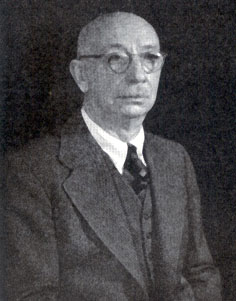Some Biogeographers, Evolutionists and Ecologists:
Chrono-Biographical Sketches
Gleason, Henry Allan (United States 1882-1975)
botany, ecology
 Photo courtesy of the Torrey Botanical Society. |
H. A. Gleason, like Henry Cowles, Frederic Clements, W. S. Cooper and others of his generation, considered himself a proponent of what was then called "dynamic ecology," emphasizing the matter of change. Gleason was first attracted by the work of Cowles, but soon found himself unable to support the idea of plant formations as superorganismal units in the manner Clements came to accept. In fact, he concluded that species tended to distribute themselves independently of one another, an idea that became known as the "individualistic hypothesis." Gleason first expressed his displeasure with the Clements model in a 1917 paper, and then ratcheted up the argument in a classic work published in 1926. Gleason was able to attract but little interest to his approach until the late 1940s and 1950s, when F. E. Egler, H. L. Mason, S. A. Cain, J. T. Curtis, and R. H. Whittaker began to support him; in the years since it has remained an important subject of discussion. Gleason was also involved in other important work including, briefly: quadrat sampling methodology (including his derivation of the Gleason Index); his early recognition of the Midwest's prairie peninsula (of grassland stretches extending into otherwise forested areas); regional vegetation history studies (especially of the Midwest and Northeast); and a large quantity of botanical taxonomy (over two hundred publications). His last two books, Manual of Vascular Plants of the Northeastern United States and Adjacent Canada and The Natural Geography of Plants, were completed after his eightieth birthday. |
Life Chronology
--born in Dalton City, Illinois, on 2 January 1882.
--1901: B.S., University of Illinois
--1904: M.A., University of Illinois
--1906: Ph.D., Columbia University
--1906-1910: instructor, then associate, in botany, University of Illinois
--1910-1916: assistant professor of botany, University of Michigan
--1913-1914: research trip to the Far East
--1916-1919: associate professor of botany, University of Michigan
--1917: publishes "The
Structure and Development of the Plant Association" in the Bulletin
of the Torrey Botanical Club
--1919-1950: serves as senior level administrator (under several titles)
at the New York Botanical Garden
--1922: publishes "The
Vegetational History of the Middle West" in the Annals of the Association
of American Geographers and "On
the Relation Between Species and Area" in Ecology
--1926: publishes "The
Individualistic Concept of the Plant Association" in the Bulletin
of the Torrey Botanical Club
--1933: founder and first editor of Phytologia
--1933-1935: vice-president, Torrey Botanical Club
--1937: president, American Society for Plant Taxonomy
--1940: vice-president, Pan-American Science Congress
--1948: president, Botanical Society of America
--1950: retires from the New York Botanical Garden; made emeritus head
curator
--1953: receives Ecological Society of America’s Distinguished Ecologist
award
--1959: receives Ecological Society of America’s Eminent Ecologist
award
--1963: publishes his Manual of Vascular Plants of the Northeastern
United States and Adjacent Canada, with Arthur Cronquist
--1964: publishes his The Natural Geography of Plants, with Arthur
Cronquist
--dies on 12 April 1975.
For Additional Information, See:
--Botanical Review,
Vol. 56(2) (1990): 91-161.
--Bulletin
of the Torrey Botanical Club, Vol. 102(5) (1975): 253-273.
--Bulletin
of the Torrey Botanical Club, Vol. 102(5) (1975): 274-277.
--Bulletin of the Ecological
Society of America, Vol. 83(2) (2002): 133-142.
*
*
*
*
*
Copyright 2007 by Charles H. Smith. All
rights reserved.
http://people.wku.edu/charles.smith/chronob/GLEA1882.htm
Return to Home/Alphabetical Listing by Name
Return to Listing by Country
Return to Listing by Discipline